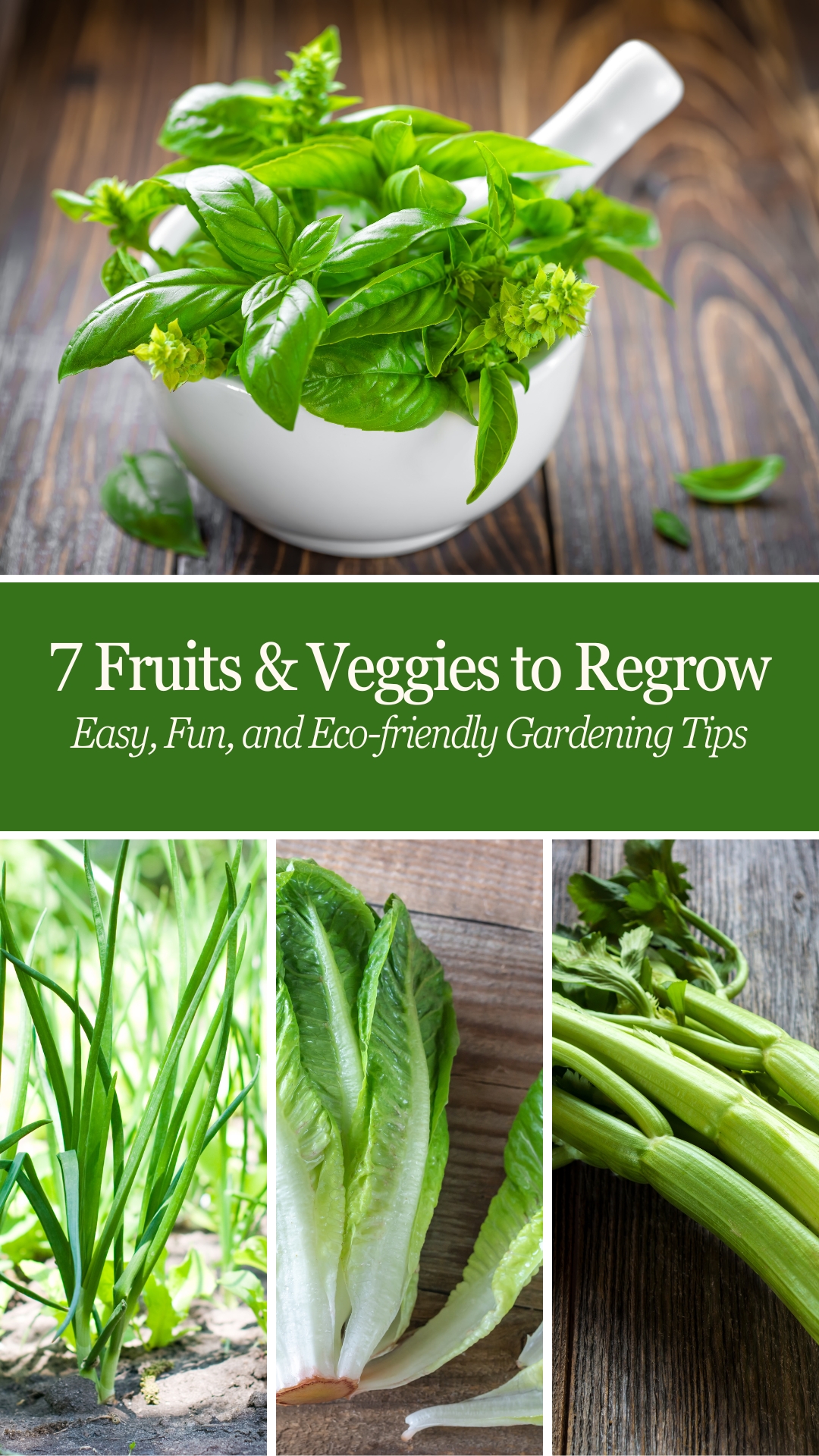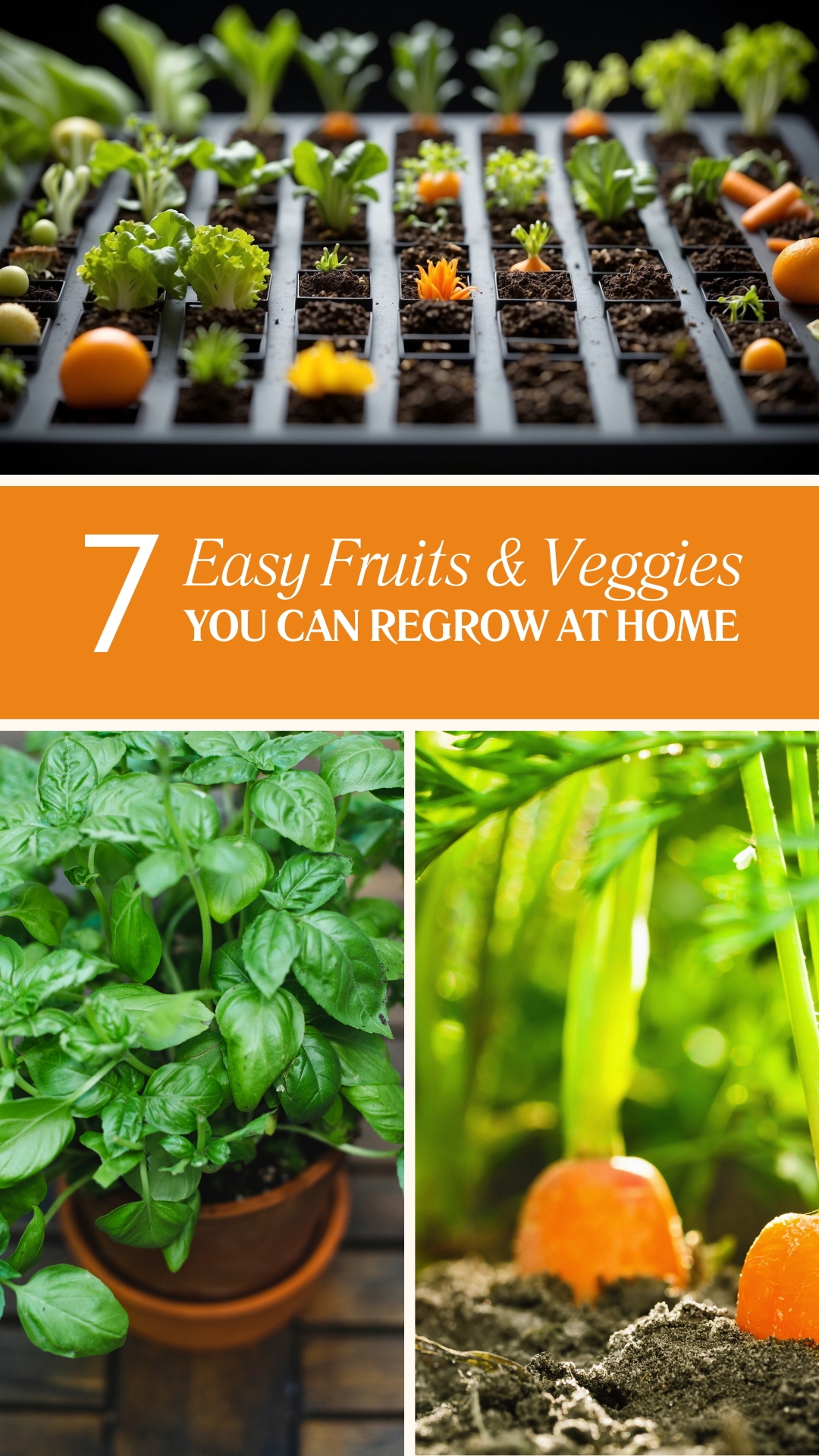Have you ever wondered if you could grow your own fruits and veggies right at home, without needing a whole garden? You can actually regrow some common kitchen scraps into fresh produce! It’s easier than you think and can save you money, too. Imagine never having to buy certain items from the store again.

This article will show you seven different fruits and vegetables that you can regrow at home. Whether you have a green thumb or not, you’ll find this a fun and rewarding activity. Plus, it’s a great way to reduce waste and live more sustainably.
1. Green Onions

Want an endless supply of green onions? Start with the ones from the store. Cut off the green stalks, leaving about an inch of the white bulb at the bottom.
Place these white bulbs in a glass of water, root side down. Ensure the roots are submerged. You’ll see new growth in a few days. How cool is that?
Change the water every few days to keep it fresh. When the green stalks grow about 5-7 inches, snip what you need and let the rest keep growing.
You can also plant the bulbs in soil for a more permanent setup. They’ll thrive in a sunny spot. Water them regularly, but don’t overdo it.
Remember, green onions can be harvested continuously. Just cut the upper part and let the lower part regrow. It’s like magic!
Growing your own green onions saves money and ensures you always have fresh ones on hand. Enjoy fresh garnishes anytime!
2. Garlic

Want to try growing garlic at home? It’s super easy! You just need a clove to start.
First, take a fresh garlic clove. Find a spot in your garden or a small pot. Make sure it’s sunny. Push the clove, pointy side up, into the soil. Cover it lightly with dirt.
Water it every few days. Soon, green shoots will pop up. These are garlic scapes, and you can eat them too!
Garlic likes well-drained soil. If your soil holds too much water, the garlic might rot. So, keep an eye on the moisture.
After a few months, you’ll see the leaves turn brown. That’s a sign your garlic is ready to harvest! Dig it up gently. Brush off the dirt but let it dry before storing.
Not only is garlic tasty, but it’s also good for you. It has vitamins C and B6, as well as selenium and manganese. Plus, it can boost your immune system.
3. Romaine Lettuce

Did you know you can regrow romaine lettuce from the scraps? It’s super easy and a fun way to get fresh greens at home.
First, save the bottom part of a romaine lettuce head. This is the part usually thrown away.
Place the base in a shallow bowl of water, with the cut side facing up. You only need about half an inch of water.
Change the water every couple of days. You’ll see new leaves sprouting from the center within a week. It’s like magic!
After a couple of weeks, the new leaves will be big enough to eat. The best part? You can repeat this process over and over again.
For better results, you can also plant the regrown base in soil. This will give the lettuce more nutrients to grow even more leaves.
4. Carrots

Carrots are super easy to regrow. You just need the tops of the carrot. The part you usually throw away can be useful!
First, cut off the tops of a few carrots. Leave about an inch of the carrot attached to the green leaves.
Place the tops in a shallow dish of water. Make sure the water covers just the bottom part.
Put the dish on a windowsill that gets a lot of sunlight. Change the water every few days.
In a week, you will see small roots grow from the carrot tops. It’s like magic!
Now, you can plant them in soil. Make a small hole and drop in the carrot tops with the roots down.
Water the soil gently. Keep the soil moist but not too wet. In a few weeks, you will see new green shoots grow.
5. Celery

Celery is easy to regrow and only needs the base of the stalk. First, chop off the stalks, leaving about 2 inches of the base. Place it in a shallow dish of water. Keep the dish in a sunny spot and change the water every couple of days.
In about a week, you’ll see new leaves growing from the base. Once the leaves appear, plant the celery in soil. Make sure to bury the base just below the soil surface. Water it regularly and watch it grow.
6. Basil

Basil is one of the easiest herbs to regrow on your kitchen windowsill. All you need is a glass of water and a sunny spot. Start by cutting a healthy basil stem, about 4 inches long. Make sure it has a few leaves at the top.
Place the basil stem in a glass of water and set it on a sunny windowsill. In a few days, you’ll see roots starting to form at the bottom of the stem. Change the water every couple of days to keep it fresh.
Once the roots are about 2 inches long, you can plant the basil in a small pot with soil. Keep it in a sunny spot and water it regularly. Soon, you’ll have a whole new basil plant ready to use in your cooking.
7. Ginger

Ginger is an amazing plant to regrow at home. Start with a piece of fresh ginger root from the store. Make sure it has at least one eye, which is a small bump.
Cut the ginger into chunks, and let the pieces dry out for a couple of days. Plant them in a pot with rich soil, with the eye facing up. Keep the soil moist, but not soaked.
After a few weeks, you’ll see green shoots coming up. Ginger grows best in a warm, humid environment. Make sure it gets some sunlight each day.
The fun part? You can start harvesting small pieces of ginger in about 3-4 months. Just dig around the edges and cut what you need. Leave the rest to keep growing.
Benefits Of Regrowing Fruits & Veggies
Regrowing fruits and vegetables at home brings several fantastic benefits. It saves money, helps the planet, and boosts your health.
Cost Efficiency
Growing your own fruits and veggies helps you save money. You don’t need to buy seeds again because you can use scraps from your kitchen. Over time, this can lower your grocery bills.
You can reduce food waste too. Leftover bits that might typically go into the trash can be replanted instead. Even small efforts here mean fewer trips to the store.
Imagine having fresh herbs like basil and mint at your fingertips. Or even growing your own lettuce and tomatoes. It’s easy and adds up in savings over time.
Environmental Impact
Regrowing fruits and veggies is good for the environment. It reduces food waste since you reuse parts of the plants. This means fewer scraps in landfills, which helps lower greenhouse gas emissions.
Growing your own plants also means you use fewer plastic containers. At the store, fruits and veggies are often wrapped in plastic. By growing your own, you cut down on this waste.
Plus, consider the positive impact of less transportation. The food you grow doesn’t need to be shipped or trucked to your home. This cuts down on fuel use and reduces your carbon footprint.
Health Benefits
Eating home-grown fruits and veggies supports better health. They’re fresher and richer in nutrients because they’re picked at their peak. Store-bought produce can lose nutrients over time during shipment and storage.
When you grow your own food, you control what goes into it. You avoid harmful pesticides and chemicals often used in commercial farming. This means cleaner, safer food for you and your family.
Gardening itself is also a healthy activity. It gets you outside and moving, providing physical exercise and fresh air. This promotes overall wellness and a healthier lifestyle.
Materials Needed For Regrowing Produce
Getting started with regrowing produce requires some tools, the right conditions, and avoiding common mistakes. Let’s break it down step by step.
Basic Tools And Supplies
You need a few items to get going:
- Containers: Small jars, cups, or pots.
- Soil: Basic potting soil works fine.
- Water: Tap water is okay, but rainwater is better.
- Light: A sunny windowsill or grow lights.
- Scissors or Knives: For cutting stems or roots.
Make sure your containers have drainage holes. Without holes, water can build up and cause roots to rot. Clear containers help you see root growth. Sturdy scissors or knives make precise cuts, which help plants grow better.
Optimal Growing Conditions
Plants need specific conditions to thrive:
- Light: Most plants need 6-8 hours of sunlight each day. Winter months may require you to use grow lights.
- Temperature: Keep the temperature between 65°F and 75°F for most plants.
- Watering: Water when the top inch of soil is dry.
- Humidity: Some plants prefer high humidity. Misting plants can help.
Maintain a balanced environment. Too much sunlight can scorch leaves, while too little can cause leggy growth. Consistent water levels prevent both underwatering and overwatering.
Common Mistakes To Avoid
Watch out for these pitfalls:
- Overwatering: Can cause root rot. Always check soil moisture before watering.
- Wrong Light Levels: Not enough light can lead to weak plants. Too much can burn them.
- Ignoring Pests: Inspect your plants regularly. Aphids, spider mites, and other pests can hinder growth.
- Poor Soil: Don’t reuse soil from other plants. Fresh soil prevents disease.
- Lack of Patience: Growth can be slow. Be patient and consistent with care.
Keeping an eye on your plants daily helps you spot issues early. Adjusting care routines as needed ensures healthy growth. Don’t be discouraged by slow progress. Plants grow at their own pace.

